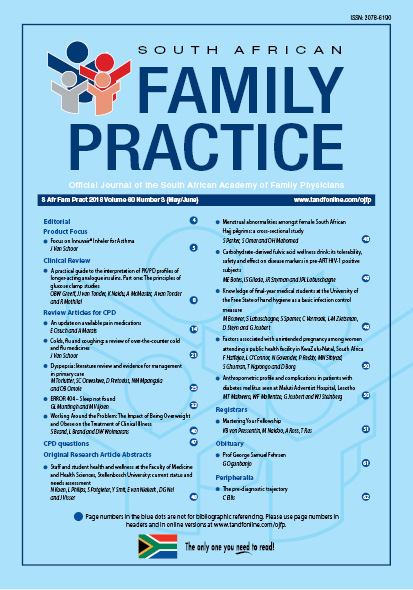Factors associated with unintended pregnancy among women attending a public health facility in KwaZulu-Natal, South Africa
Keywords:
pregnancy, public sector health care, South Africa, unintended pregnancy
Abstract
Background: Across the globe a large proportion of pregnancies have been reported as unintended. There are no available reports from South Africa concerning the prevalence of unintended pregnancies. This study explored the prevalence of unintended pregnancies among South African women attending a public primary health care (PHC) clinic in KwaZulu-Natal (KZN), South Africa. It also investigated the relationship between demographic factors, contraceptive use, substance abuse and unintended pregnancy in this setting. Methods: A descriptive cross-sectional survey was conducted among patients (n = 328) attending a PHC clinic. Participants were recruited by convenience sampling. Women who attended the clinic on their first antenatal visit were invited to participate. Participants filled out questionnaires in either English or isiZulu. Association between pregnancy and categorical variables was assessed. Results: Participants were mostly single (89.9%; n = 267), unemployed (70.8%; n = 222) with a monthly income of less than R 1 500 per month (63.8%; n = 81). Two-thirds of the women (64.33%; n = 211) had unintended pregnancies. There was a significant relationship between marital status and unintended pregnancy. Women who were married or living with their partners were more likely to have planned their pregnancies as compared with those who were single or divorced. Unemployed women were more likely to have had unintended pregnancies. No other socio-demographic factors were linked to unintended pregnancy. Conclusion: It is concluded that in this population of South African women with low education levels and low income, the prevalence of unintended pregnancies is high. These unintended pregnancies are linked to single status as well as unemployment. (Full text of the research articles are available online at www.medpharm.tandfonline.com/ojfp) S Afr Fam Pract 2018; DOI: 10.1080/20786190.2017.1396790
Section
Research Articles
By submitting manuscripts to SAFP, authors of original articles are assigning copyright to the South African Academy of Family Physicians. Copyright of review articles are assigned to the Publisher, Medpharm Publications (Pty) Ltd, unless otherwise specified. Authors may use their own work after publication without written permission, provided they acknowledge the original source. Individuals and academic institutions may freely copy and distribute articles published in SAFP for educational and research purposes without obtaining permission.

